
About UsThe Numismatic Bibliomania Society is a non-profit organization promoting numismatic literature. For more information please see our web site at coinbooks.org SubscriptionsThose wishing to become new E-Sylum subscribers (or wishing to Unsubscribe) can go to the following web page link MembershipThere is a membership application available on the web site Membership Application To join, print the application and return it with your check to the address printed on the application. Membership is only $20 to addresses in the U.S., $25 for First Class mail, and $30 elsewhere. For those without web access, write to: David M. Sundman, Treasurer AsylumFor Asylum mailing address changes and other membership questions, contact David at this email address: dsundman@LittletonCoin.com SubmissionsTo submit items for publication in The E-Sylum, just Reply to this message, or write to the Editor at this address: whomren@gmail.com
BUY THE BOOK BEFORE THE COIN |
- WAYNE'S WORDS: THE E-SYLUM JULY 6, 2014
- PRINTSASIA NUMISMATIC BOOK CATALOG
- NEW BOOK: KALIGHAT HOARD
- NEW BOOK: COINS FROM BANGLADESH
- HARDCOVER NEWMAN SALE IV AVAILABLE
- BOOK REVIEW: MORGAN DOLLAR
- BOOK REVIEW: PANIC SCRIP OF 1893, 1907 AND 1914
- IAPN 2014 GENERAL ASSEMBLY HELD IN MONACO
- NOTES FROM E-SYLUM READERS: JULY 6, 2014
- WHAT IS THAT ON THE TURKISH COIN?
- MORE DEBATE ON LOOTING AND COLLECTING
- HOW MANY ANCIENT COINS ARE FAKES?
- MORE ON SIBERIAN MINT MARKS
- 1755 DRURY LANE THEATRE ROYAL PASS
- THE NEW HAMPSHIRE FEMALE CENT INSTITUTION
- MORE ON 1863 CSA INGOTS
- SLACKING AT WORK, MAKING COUNTERFEITS
- THE NUMISMATIC CONTRIBUTIONS OF BOB EVANS
- A. CHARLES GIES, NUMISMATIST
- DIGITIZE YOUR BOOKS FOR $1 EACH
- NLG NEWSLETTER GOING ALL-DIGITAL
- STACK'S BOWERS TO OFFER GARRETT 1804 DOLLAR
- 1865 EGYPTIAN SUEZ CANAL WORKERS TOKEN
- RUSSIA TO ISSUE CRIMEA BANKNOTE
- NUMISMATICS AT BURG CASTLE
- BEP ANNOUNCES CURRENCY READER FOR THE BLIND
- LEUVER ON CURRENCY READERS FOR THE BLIND
- ACADEMY SUES OVER AUCTIONED OSCAR
- LAUNDERING MARIJUANA MONEY WITH FEBREZE
- A STUDENT OF TIPPING STRATEGY
- BOOKBENCHES INVADE LONDON
- FEATURED WEB PAGE: COIN CABINET OF THE ROYAL LIBRARY OF BELGIUM
Click here to access the complete archive
To comment or submit articles, reply to whomren@gmail.com
WAYNE'S WORDS: THE E-SYLUM JULY 6, 2014

Our new subscribers this week include Heather Schena, Lance Casagrande and F. Loomis. Welcome aboard! We have 1,739 email subscribers.
VACATION TIME! I'll be travelling with my family for a summer vacation starting Friday. Next week's E-Sylum issue (July 13) will be abbreviated and we likely won't publish on July 20. Meanwhile, continue enjoying numismatics as usual.
This week we open with a numismatic book catalog from PrintAsia, two new books (and one great catalog), plus two book reviews. Other topics include the AIPN General Assembly, ancient coins in the marketplace, theatre tokens, Bob Evans, Charlie Gies, and numismatic at Burg castle.
To learn more about the Kalighat hoard, the Little Free Library, the King Croesus Hippocampus brooch, the micropalenotologist and the immunopharmacologist, and laundering marijuana money with Febreze, read on. Have a great week, everyone!
Wayne Homren
Editor, The E-Sylum

PRINTSASIA NUMISMATIC BOOK CATALOG
Sherry Helms writes:
 Allow me to introduce ourselves to you. We are an online retail bookstore with a good collection of popular and rare books in Numismatics. We have attached a small catalogue containing books on numismatics for your reference. You can also see the Catalogue by clicking this link: Numismatics Catalogue
Allow me to introduce ourselves to you. We are an online retail bookstore with a good collection of popular and rare books in Numismatics. We have attached a small catalogue containing books on numismatics for your reference. You can also see the Catalogue by clicking this link: Numismatics Catalogue
We source and update catalogues from more than 2000 big and small publishers from USA, UK and India publishing books on numismatics and related subjects.
You can also subscribe to our catalogue by sending us a request on sherry@printsasia.com. You can enquire for any books by sending an email at web@printsasia.com. To place order directly please visit Printsasia.com.
From the PrintAsia.com site:
Shipping Rates
We deliver books worldwide and ship via multiple carriers like USPS/UPS (for domestic, U.S.), Asia Expedited Shipping (For Asian Countries and Australia), Europe Shipping (for all the countries of Europe), and International Delivery (for rest of the world).
What is unique in our International Delivery System is that we do not charge flat rate per item instead we offer delivery rates on the basis of weight of each additional item. This makes our international delivery pricing structure extremely pocket friendly when compared to other booksellers.
To visit PrintAsia web sites (U.S. U.K., and Germany), see:
www.printsasia.com
www.printsasia.co.uk
www.printsasia.de
To read the earlier E-Sylum article, see: BETTER PRICES FOR NUMISMATIC BOOKS FROM INDIA (www.coinbooks.org/esylum_v17n24a05.html)
NEW BOOK: KALIGHAT HOARD
 Kalighat Hoard: The First Gupta Coin Hoard from India
Kalighat Hoard: The First Gupta Coin Hoard from India
Authors (s): Susmita Basu Majumdar (Author)
Format: Hardcover
ISBN-13: 9789351567264
Pages: 125p., 43 Colour Plates
Pub. date: 30.06.2014, 1st. ed.
Publisher: Mira Bose
Language (s): English
Bagchee ID: BB87339
List price: US $ 76,00
Bagchee price: US $ 68,40
This book narrates the fascinating story of the discovery of the first hoard of Gupta coins from India which was found in Kalighat, located in the southern part of Kolkata (Calcutta). There were more than 200 coins in this hoard. Records mention that one Nab Kissen handed over this hoard to Warren Hastings. The research has identified Nab Kissen of the records with Raja Nabakrishna Deb, a person of considerable eminence in 18th century Calcutta. The land which yielded the hoard belonged to his family. The person who actually found the hoard remains anonymous, but he did hand over more than 200 coins in pot to Nabakrishna Deb.
There was a confusion regarding the pot; some reports mentioned that it was an earthen one. There was even a confusion regarding the location: one of the reports mentioned the provenance as Benaras. However, Nabakrishna was amunshi (Persian writer) in the East India Company and in 1783 he gave the hoard to Warren Hastings in anticipation of some favours. Hastings also handed over the hoard to the Court of Directors in London. But he kept a few coins with him (around thirty or so) and sent 172 to London (this no. is recorded). No one kept a record of the coins.
However, for all practical purposes the hoard was thought to be lost when the Court of Directors sent these coins to different collections in the UK without keeping any record. When Hastings returned to London he found only 24 coins in the British Museum collection and was informed that rest went to the melting pot. He was astonished as he thought he had made the most magnificent contribution by handing this hoard to the Court of Directors. None knew that these were Gupta coins. Hastings wrote that he was sending Persian Darics! It was 1825 that when Marsden had prepared his catalogue Nusmiamata Orientalia, he gathered a lot of information about the hoard and identified them as Gupta coins. The next Gupta hoard was discovered in 1850.
Through painstaking research, the author has gathered together all the coins that may have belonged to the original hoard, and thereby reconstructed the first Gupta hoard from Bengal and India. The coins were sent to India Office Collection which later came back to British Museum and Bodliean collection, now Ashmolean Museum (Oxford), Fitzwilliam Museum (Cambridge). The East India Company held a few more which later came back to British Museum and around 20 were handed over to Hunterian Collection in Glasgow, Scotland to the private museum of Mr. Hunter. He had already expired, yet his collection was the best in UK. His collection was indeed enriched by the coins. Some coins were given to private individuals who later gifted them or sold them to the British Museum. The present author has traced the history of each such private collector and included them in the current Kalighat list.
The coins had been placed in a brass pot that remained submerged in water for long time. Hence, this resulted in an inevitable chemical reaction of water with brass, gold, alloy (especially debased gold as most of the coins belong to Narasimhagupta and Vishnugupta which are highly debased) and the alluvium. The coins acquired a characteristic clayish black patina. This also confirmed that the pot was a brass pot and not earthen pot. It is on the basis of the patina coating that the present author has identified the hoard. She has also attempted to reconstruct its history and its association with Nabakrishna. The book also provides a sketch of the 18th century scenario of Calcutta and a brief history of Nabakrishna Deb.
The historical implications of this hoard have also been discussed in this book. Joe Cribb, Retired Keeper, Department of Coins and Medals, British Museum has written a foreword for the book and the Gupta coins specialist Ellen M Raven from Leiden has added a Prologue.
Joe Cribb situates the work of the present author in the light of previous researches, and points out how Marsden’s wishes have been fulfilled in this publication after a prolonged wait.
In her Prologue, ‘Gupta Coins in the Digital Age’, Ellen Raven points out how the study of the Gupta coins have taken gained momentum with the coming of digital photography. Interestingly, the author has included the coins of Sasanka and Jayanaga in this hoard on the basis of she calls ‘the author’s hunch’ since though there is no supportive evidence. She noticed similar corrosive effects on the coins of these two rulers in the collections of the British Museum. Besides, the date of accession also led her to infer that these may have been a part of the original hoard. If so, then the date for the deposition of the hoard can be pushed back to the 7th century CE.
The last chapter of the book entitled, Epilogue, highlights the contemporary material milieu when these Gupta coins were in circulation. It highlights the monetary scenario in the overall economic condition in the Gupta realm. It also gives three tables (i) a genealogical chart after M. Willis; (ii) A chart showing Gupta coin hoards from Bengal; (iii) a chart showing the number coins per ruler along with all relevant details. There are excellent colour reproductions of coins in chronological order along with a map indicating the find spots of Gupta coins from Bengal.
The exhaustive catalogue of all the 128 coins belonging to the Kalighat hoard provides all the data regarding their present location with accession numbers. These have again been divided into two parts: 117 are enlisted as Kaligaht coins and 11 coins are a part of the probable list based on ‘author’s hunch’. There are photographs of 18th century Kaligaht courtesy Kern Institute sent by Ellen Raven. Photographs also include Sobha Bazar Rajbari (palace) and Nabakrishna’s portrait in an oil painting, courtesy Pratip Krishna Deb, a member of the Sobha Bazar princely family (i.e. Nabakrishna’s heir).
For more information, or to order, see: Kalighat Hoard: The First Gupta Coin Hoard from India (www.bagchee.com/books/BB87339/kalighat-hoard-the-first-gupta-coin-hoard-from-india)
NEW BOOK: COINS FROM BANGLADESH
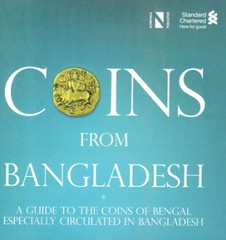 Coins From Bangladesh: A Guide to the Coins of Bengal Especially Circulated in Bangladesh
Coins From Bangladesh: A Guide to the Coins of Bengal Especially Circulated in Bangladesh
Authors (s): Bulbul Ahmed (Author) , A.K.M. Shahnawaz (Author)
Format: Hardcover
ISBN-13: 9789849015987
Pages: 264p.,
Pub. date: 31.12.2013, 1st. ed.
Publisher: Nymphea Publication
Language (s): English
Bagchee ID: BB87345
List price: US $ 100,00
Bagchee price: US $ 90,00
From the preface: Bangladesh has a glorious numismatic heritage which had been practiced from the pre-Christian era. A good number of coins of ancient medieval and colonial periods have been obtained from all over Bangladesh. Broadly ancient period is represented by punch-marked coin, copper cast coin, Kushana coin, Gupta coin, the coins of Shashanka Samachardeva, Jayanaga Mainamati gold coin, and Harikela coin.
The medieval period is introduced by the issues of Delhi Sultans, Independent Bengal Sultans, and the coins of the Afghan and the Mughal emperors. A Profuse number of coins were struck during this period. Modern period comprised the coins of the British East India Company, the British Indian rulers, and the coins of Pakistan and Independent Bangladesh. In 1971 East Pakistan became the Independent nation of Bangladesh with the Pakistani rupee as its interim currency. The taka became Bangladesh’s currency replacing the Pakistani rupee in 1972.
Contents: 1. Coins of the ancient period. 2. Coins of the Sultani period. 3. Coins of the Afghan period. 4. Coins of the Mughal period. 5. Coins of the Hindu rulers of the Muslim period Jaintia coins. 6. Coins of the colonial period. 7. Coins of the Pakistan period. 8. Coins of Bangladesh. Key to plates.
To read the complete article, see: Coins From Bangladesh (www.bagchee.com/books/BB87345/coins-from-bangladesh-a-guide-to-the-coins-of-bengal-especially-circulated-in-bangladesh)

HARDCOVER NEWMAN SALE IV AVAILABLE
 The fourth sale of selections from the Eric P. Newman Numismatic Society (EPNNES) collection featured nearly 700 lots from its very important collection of American colonial coins. Held in New York on May 16-17, the sale realized over $11 million.
The fourth sale of selections from the Eric P. Newman Numismatic Society (EPNNES) collection featured nearly 700 lots from its very important collection of American colonial coins. Held in New York on May 16-17, the sale realized over $11 million.
Highlights included the 1776 silver Continental dollar graded NGC MS63 and a 1792 pattern silver center cent in NGC MS63BN, which sold for $1,410,000 each. The auction brought the total prices realized for Newman Parts I-IV to almost $45 million.
These cardinal red gilt-embossed deluxe editions are a fitting tribute to an extraordinary collection and an extraordinary man. Each catalogue is illustrated in full color and includes reprints of monographs by Eric P. Newman.

Single copies of Sale IV of the Eric P. Newman Collection are available for purchase through our online bookstore at numislit.com for $125 plus $5 shipping.
Subscriptions to the entire series of Eric P. Newman Collection sales can be ordered at numislit.com for a cost of $95 plus $5 for each issue.
Items being sold are from the extensive collection of Eric P. Newman Numismatic Education Society (a Missouri not-for-profit corporation) and have been assembled over a period of 90 years. Proceeds of the sale of all items will be used exclusively for supplementing the Society’s museum operations and scholarly numismatic research efforts and for the benefit of other not-for-profit institutions selected by Eric P. Newman Numismatic Education Society for public purposes.
For more information, or to order, see: ERIC P. NEWMAN COLLECTION SPECIAL HARDCOVER EDITION. SALE IV. Single Copy of Sale IV: American Colonial Coins (www.numislit.com/shop/numislit/02697.html)
BOOK REVIEW: MORGAN DOLLAR
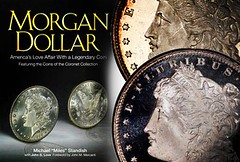 Last month Whitman Publishing released the new book, Morgan Dollar – America’s Love Affair With a Legendary Coin by Michael “Miles” Standish. At the recent Whitman Baltimore Summer Expo, I received a copy and had a chance to read it on my long trip back west.
Last month Whitman Publishing released the new book, Morgan Dollar – America’s Love Affair With a Legendary Coin by Michael “Miles” Standish. At the recent Whitman Baltimore Summer Expo, I received a copy and had a chance to read it on my long trip back west.
Standish does an excellent job bringing the story of the Morgan dollar to life. His book is filled with great information and colorful illustrations. He is able to relate a quick historical background giving the reader a great sense of the times and circumstances that surrounded the inception and the continued production of the famed silver dollar. His nutshell explanation of the acts and economics that brought to life American numismatic’s most popular series condenses the information into an entertaining and quick read.
Standish dives into the silver dollar market giving a quick study of the early markets, while touching on the personalities and numismatists whose collecting and promotion of the series were instrumental in creating the vast silver dollar market that exists today.
The book’s date analysis gets away from the dry statistical reporting of facts and gives instead a coin by coin story illustrated wonderfully with the Cardinal Collection examples. It reads like a diary of Morgan’s great design and the factors that went into each year at Philadelphia and the branch mints. He’s able to touch on pertinent facts unique to individual dates and still keep the overall picture in sight.
To read the complete article, see: Book Review: Morgan Dollar – America’s Love Affair with a Legendary Coin (www.coinweek.com/books-2/book-review-morgan-dollar-americas-love-affair-legendary-coin/)
BOOK REVIEW: PANIC SCRIP OF 1893, 1907 AND 1914
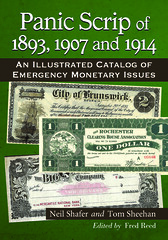 Panic Scrip of 1893, 1907 and 1914 An Illustrated Catalog of Emergency Monetary Issues, By Neil Shafer and Tom Sheehan, Edited by Fred Reed, 2013, published by McFarland, Jefferson, North Carolina, Reviewed by John and Nancy Wilson
Panic Scrip of 1893, 1907 and 1914 An Illustrated Catalog of Emergency Monetary Issues, By Neil Shafer and Tom Sheehan, Edited by Fred Reed, 2013, published by McFarland, Jefferson, North Carolina, Reviewed by John and Nancy Wilson
The long-awaited new book on Panic Scrip of 1893, 1907 and 1914 is here at last. Never had anyone covered these three periods of the panic in such an authoritative and comprehensive manner. Like many others, we provided dozens of photos of panic scrip notes from our collection.
This new Panic Scrip book is soft cover (7 X 10), with 416 pages and 808 black and white illustrations. The illustrations are shown at 60 percent to 90 percent of original size; each is marked as to the precise percentage. The acknowledgments contain about 70 individuals along with the ANA, ANS, Eric P. Newman Numismatic Education Society and Smithsonian Institution. The authors obtained some funding from the Central States Numismatic Society, Milwaukee Numismatic Society, Numismatists of Wisconsin, South Shore Coin Club and the Society of Paper Money Collectors.
The Preface discusses the economic downturns that caused panic scrip notes to come into existence. Sources of notes and information came from great collectors such as Maurice Burgett, Chester Krause and Herb and Martha Schingoethe and several institutions named in the book. The authors were greatly helped by Douglas Corrigan who provided a compilation and census of 1907 scrip notes.
How to Use This Book explains the new cataloging system used in the book. The types of notes listed in this reference are 1. Clearing House Loan Certificates. 2. Clearing House Certificates. 3. Clearing House Checks. 4. Cashier’s Checks. 5. Payroll Checks. Also covered are issues that aren’t included; note descriptions; general characteristics and the states of existence (designations by each note let you know if it is issued, unissued, sample, specimen, and proof, unreported or other factor). The rarity of these notes is explained along with rarity ratings and values. As an example of how rare these issues are, the Milwaukee Clearing House Certificates are mostly all R5 (highest rarity) with only one to five known of each.
Part 1. Scrip from the Panic of 1893. The book explains the causes of this panic, such as the drop in commodities and crops; the Sherman Silver Purchase Ace of 1890; railroad failures and bank failures; the stock market collapse; problems after President Grover Cleveland was sworn into office and other economic upheavals of that time. The recovery from this panic started with the election of President McKinley in 1896.
Part ll. Scrip from the Panic of 1907. History of the “Rich Man’s Panic,” gives you insights on how this panic evolved from the early 1900s to the actual panic itself in 1907. Much of the information is excerpted from this book. From the good years of President McKinley and his slogan, “The Full Dinner Pail,” to the administration of President Roosevelt and the start of this panic, the authors give you the reasoning and logic for the Panic of 1907.
“Heinze and the Development of the Panic,” explains how he and C. F. Morse were relatively newcomers to Wall Street and yet, they did have a reputation as fast wheelers and dealers. Heinze, who was a copper speculator, became involved in banking as a President of the Mercantile National Bank. Because of his involvement as a speculator, many depositors removed their funds from this bank. Charles Barney, President of the Knickerbocker Trust, had a good relationship with Heinze. Because of that relationship, it caused the National Bank of Commerce to refuse to clear for the Knickerbocker. Though Barney resigned, fear spread among its 18,000 depositors and in short order there was a run on the firm and it was forced to close its doors. This action occurred October 21, 1907, and the panic of 1907 had begun. Unfounded fear rapidly spread across the country and runs on banks started in large and small cities in the country. Bank Holidays were declared by Governors in some states and emergency notes soon appeared in various forms and from several different entities. In several months, it is estimated that nearly 500 million in currency substitutes circulated during this period. In reflecting back on Heinze, it is hard to believe that he probably was the person most instrumental in starting the Panic of 1907.
“Intercession of J. Pierpont Morgan,” Mr. Morgan was very instrumental in bringing it to an end. While watching all the events, he was content to let the Knickerbocker bank fail, but he knew that the panic had to be stopped. With his great wealth and connections with the President, Wall Street executives, banking and brokerage officials and the Treasury Secretary George Cortelyou, he started the wheels in motion to place money into circulation. By acting as a virtual one-man federal reserve bank, Morgan literally saved the day. By February, 1908, the panic was brought to an end.
“Aftermath of the Panic.” In 1908 the Aldrich-Vreeland Currency Act was passed which commissioned many changes in the banking system. After extensive changes a Virginia Democrat, Carter Glass, proposed the Federal Reserve Act in 1913. President Wilson saw to it that the bill was pushed through Congress and the Federal Reserve Bank System was born. This system provided the needed elasticity.
We can remember in the early 1990s at a Milwaukee convention. A local dealer was able to obtain three Milwaukee Clearing House Scrip 1907 notes from a local retired banker. The dealer asked us what they were worth. We quickly went to Neil Shafer and asked him. He said $25 or $30 each. The Wilson, Bertschy and Shafer collections each got a note that wasn’t readily available in the marketplace. When Dean Oakes (Hickman & Oakes) auctioned off the Bertschy collection, we were able to pick up a few more of these Milwaukee Clearing House scrip notes.
Part lll. Scrip From The Financial Crisis of 1914. The crisis at the outbreak of World War 1 caused gold to quickly disappear which imperiled America’s ability to repay its debts abroad. Fear quickly spread worldwide that the U. S. would “abandon the gold standard.” The dollar plummeted on world markets. The New York Stock Exchange was shut down by William Gibbs McAdoo for four months, “to prevent Europeans from selling their American securities and demanding gold in return.” McAdoo brought about a “great deal of emergency currency” as he didn’t want to see a repeat of the Panic of 1907. Because of McAdoo’s intervention the authors say that, “All these fiscal achievements removed most of the need for local scrip, accounting for the very few issues found in this section of the catalog.” The Federal Reserve came into existence as the 1914 crisis waned. McAdoo “served as the first chairman of the Federal Reserve Board.
Appendix A. 1907 Pseudo or Parody Scrip. This section contains scrip that resembles the 1907 panic scrip. Resembling currency the makers of these notes were hopeful the public would pick them and then read the advertising messages that were on them. The three pages contain only eight pieces and five of them are R5.
Appendix B. Miscellaneous Scrip. The authors used auctions, collectors and their collections, along with many other sources that provided notes for this project. The 12 pages of scrip contained in this section are pieces that didn’t fit into the 1893, 1907 or 1914 chapters. Instead of not using them at all, the authors placed these notes into this section which they call the “lost” notes.
Appendix C. The Clearing House Certificate as a Cash Substitute, 1857-1933. Professor Loren Gatch, the author, explains all the reasons that Clearing House Scrip came into existence. Over the years many books and articles have covered economic conditions between 1857 and 1933. Now, in only 15 pages, Professor Gatch covers these economic conditions in an interesting and easy to read manner. Clearing House Loan Certificates are explained between the periods of 1860 to 1884. The three different periods in this book are covered. The period of 1933 is even covered. Were Clearing House Certificates and Other Emergency Monies Legal? You will see the court rulings and other laws that made this emergency money legal. The importance of the Aldrich-Vreeland Notes of 1914 is also covered. The conclusion of this article explains in only three paragraphs the rise and fall of clearing house certificates.
Appendix D. G. G. B. DeBernardi Labor Exchange Scrip of 1895-1905. Authored by Steven K. Whitfield. In 2009 our good friend Steven Whitfield authored a book on Kansas Paper Money, An Illustrated History, 1854-1935, which contained a few pages of information on DeBernardi scrip issues. That information is in this new book.
The Bibliography and Index close out this reference. This is important information for researchers and collectors.
What an excellent book and source of information for these rare Panic Scrip of 1893, 1907 and 1914 notes. The many years of research by the authors finally came to fruition with the publication of this important reference. A subject “NEVER BEFORE COVERED,” we consider this a must buy for all numismatists. We thank Neil and Tom, along with the other contributors for writing this important reference. For information on purchasing this book, it is available for $75 from the publishers: McFarland & Co. Inc., Box 611, Jefferson, North Carolina 28640, Phone No. (800) 253-2187, www.mcfarlandpub.com or Email info@mcfarlandpub.com
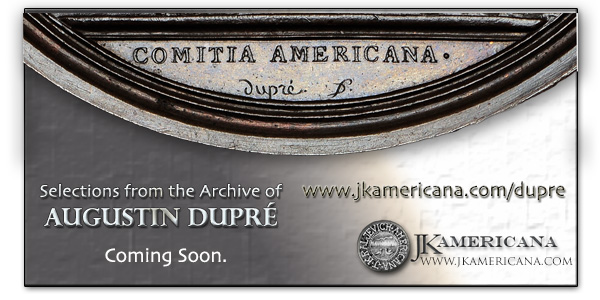
IAPN 2014 GENERAL ASSEMBLY HELD IN MONACO
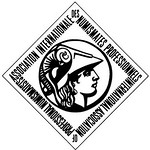 The International Association of Professional Numismatists (I.A.P.N.) held its 63rd General Assembly in Monte Carlo, May 29th-June 1st 2014 in the Principality of Monaco. A total of thirty eight of the world’s leading numismatic firms met to attend the congress, with an additional twenty one firms represented via proxy.
The International Association of Professional Numismatists (I.A.P.N.) held its 63rd General Assembly in Monte Carlo, May 29th-June 1st 2014 in the Principality of Monaco. A total of thirty eight of the world’s leading numismatic firms met to attend the congress, with an additional twenty one firms represented via proxy.
The I.A.P.N. meets annually to conduct its congress, which is held in a different city and country each year as voted on by its members. This year the congress was hosted by the firm Editions Victor Gadoury from the Principality of Monaco. The I.A.P.N. would like to extend a special thank you to the organizers, the Pastrone family (Frederico and Giovanna) and the staff of Editions Victor Gadoury (Moira, Emanuele and Muriel) for a successful and well planned congress. This marks the third I.A.P.N. congress to be held in Monaco; the 12th general assembly was held there in 1963 and the 38th in 1989.
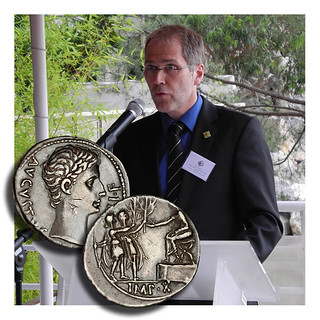 In his welcoming address, I.A.P.N. president Arne Kirsch discussed the city’s numismatic history and historical sites. The first coin he discussed in relation to Monaco was a denarius of the Roman Emperor Augustus struck in 15 B.C. at Lugdunum (current day Lyon, France), to commemorate the campaign over the Alps by Drusus and Tiberius. During this campaign the Romans conquered numerous local tribes, gaining control of the vital coastline. The Roman monument “Tropaeum Alpium” or Victory Monument of the Alps” was erected in 6 B.C. a few kilometres from Monaco in commemoration of this campaign.
In his welcoming address, I.A.P.N. president Arne Kirsch discussed the city’s numismatic history and historical sites. The first coin he discussed in relation to Monaco was a denarius of the Roman Emperor Augustus struck in 15 B.C. at Lugdunum (current day Lyon, France), to commemorate the campaign over the Alps by Drusus and Tiberius. During this campaign the Romans conquered numerous local tribes, gaining control of the vital coastline. The Roman monument “Tropaeum Alpium” or Victory Monument of the Alps” was erected in 6 B.C. a few kilometres from Monaco in commemoration of this campaign.
The first coinage types issued in the Principality of Monaco were produced during the reign of Honore II. A few types were issued during the Spanish protectorate in the early 1640s; these are quite rare today. Later Monaco was granted the concession to produce coinage by the King of France in 1643, and by 1648 the mint was fully functional, producing coinage on a regular basis. The principality of Monaco has a rich numismatic history associated with the study and collecting of coinage. In fact the standard reference “History of the Monies, Medals and Tokens of Monaco” by Raymond de Vos was based in part on the collection of His Serene Highness Prince Rainier III, now housed in the Musée des Timbres et des Monnaies.
The congress opening ceremonies were further graced by the presence of His Serene Highness the Sovereign Prince of Monaco, Prince Albert II. The prince was gracious in addressing the members of the organization, welcoming them to Monaco, after which food and beverages were served. President of the I.A.P.N. Arne Kirsch presented His Serene Highness the Sovereign Prince of Monaco with the official medal of the organization featuring a portrait of famous numismatist and author and first I.A.P.N. president, Leonard Forrer. Quite possibly the medal will find its way into the royal collection housed in the Musée des Timbres et des Monnaies as a reminder of the 63rd annual numismatic congress which was held in Monaco.
A moment of silence was observed for three I.A.P.N. members who had recently passed. Former I.A.P.N president Paul Divo was among those remembered. He served as a member of the executive committee for more than 20 years, including as secretary and president. His name is well known among dealers and collectors for his impact on the community and for his many numismatic works. His specialized works on the coinage of Greece and Liechtenstein as well as French medals remain standard references, as do his collaborations on Swiss and German coinage.
Also remembered was Robert Schulman of the world famous Amsterdam numismatic firm of the same name. The Schulman family has a long tradition of numismatics dating back to the company’s founding in 1880. Robert served on the I.A.P.N. executive committee and was president of the organization from 1985-1991.
The organization also lost former member, numismatist and coin dealer Romolo Vescovi. An all-around warm hearted person and good friend, Vescovi was largely responsible for the planning and organization of the 53rd annual congress held in Rabat, Morocco.
 Among the many topics discussed at this year’s congress, were the recipients of this year’s book prize award. As usual, several excellent numismatic publications and references were submitted for consideration, 15 in total, all of which were voted on by the membership, some ranking very closely in the final outcome. As per I.A.P.N. tradition, after voting the submitted books are donated to an institution or library in the country in which the congress is being held. The I.A.P.N. would like to thank all of the contributing authors and recognize their hard work in publishing these excellent references. Following is a list of the submitted works in order of first through third place.
Among the many topics discussed at this year’s congress, were the recipients of this year’s book prize award. As usual, several excellent numismatic publications and references were submitted for consideration, 15 in total, all of which were voted on by the membership, some ranking very closely in the final outcome. As per I.A.P.N. tradition, after voting the submitted books are donated to an institution or library in the country in which the congress is being held. The I.A.P.N. would like to thank all of the contributing authors and recognize their hard work in publishing these excellent references. Following is a list of the submitted works in order of first through third place.
 First Place: ITALO VECCHI
First Place: ITALO VECCHI
ITALIAN CAST COINAGE –A DESCRIPTIVE CATALOGUE OF THE CAST BRONZE COINAGE AND ITS STRUCK COUNTERPARTS IN ANCIENT ITALY FROM THE 7TH TO 3RD CENTURIES BC
ITALO VECCHI 2013
ISBN978-0-9575784-0-1
 Second Place: KIRK BENNETT
Second Place: KIRK BENNETT
A CATALOG OF GEORGIAN COINS FIRST EDITION
2014 STEPHEN ALBUM RARE COINS
ISBN 978-0-578-13771-1
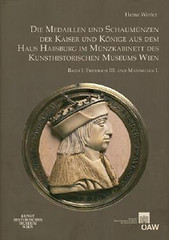 Third Place: HEINZ WINTER
Third Place: HEINZ WINTER
DIE MEDAILLEN UND SCHAUMUENZEN DER KAISER UND KOENIGE AUS DEM HAUS HABSBURG IM MUENZKABINETT DES KUNSTHISTORISCHEN MUSEUMS WIEN – BAND I
VERLAG DER OESTERREICHISCHEN AKADEMIE DER WISSENSCHAFTEN WIEN 2013
ISBN978-3-7001-7502-5
The 64rd annual congress of the I.A.P.N. is scheduled to take place in 2015 in New Orleans Louisiana, hosted by the Mike Dunigan Company. Its 65th annual congress is scheduled for 2016 in Amsterdam, Netherlands, as proposed by the firm Schulman b.v.
The I.A.P.N. recently finished the first stages of development for its new website www.iapn-coins.org, which was launched just prior to the congress in Monaco. The site can be used in both official languages of the organization, French and English. The homepage features a newsfeed updated with the most recent I.A.P.N. press releases and news. It also features an auction calendar and a list I.A.P.N. firms that are conducting upcoming sales. The public face of the website includes a list of I.A.P.N. publications, past winners of the book prize, membership directory, stolen coin archives and general information regarding the organization. Members of the organization are granted access to the private side of the site, which features internal news and a searchable database of coin forgeries.
To visit the I.A.P.N. site, see: www.iapn-coins.org
NOTES FROM E-SYLUM READERS: JULY 6, 2014
The Bank of St. Louis Last week we quoted an article about the Newman Money Museum which began, "To see what St. Louis looked like when it was founded 250 years ago, you have to head to a Washington University basement and look for a ten dollar bill."
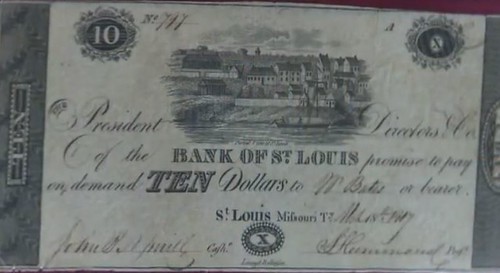
Ron Thompson of Decatur, GA writes:
Really, 250 years? perhaps 198 years, but what is 52 years amongst friends? The note in the article is from the Bank of St. Louis that only existed between 1816 and 1819 according to United States Obsolete Bank Notes 1782-1866 by James A. Haxby.
To read the earlier E-Sylum article, see: NEWS CREW VISITS NEWMAN MONEY MUSEUM (www.coinbooks.org/esylum_v17n27a06.html)
Spawn of the Demonic Typo Dick Johnson writes:
While I am surprised and delighted three readers wrote last week that I had misspelled "denominations" in a previous article. So delighted, in fact, I plan to misspell one word in every future article. It proves someone out there actually reads my stuff.
To read the earlier E-Sylum article, see: NOTES FROM E-SYLUM READERS: JUNE 29, 2014 : Demonic Typo (www.coinbooks.org/esylum_v17n27a08.html)
Royal Canadian Mint Plans High-Denomination Collector Coins Dick Johnson adds:
While the U.S. argues over the composition of the cent -- "paper or plastic" -- Canada is planning on issuing a $1,000 coin and one of $1,250 denomination.
To read the complete article, see: $1,000 coin in the works at Royal Canadian Mint (www.ctvnews.ca/business/1-000-coin-in-the-works-at-royal-canadian-mint-1.1894167)
Little Free Library Jeff Reichenberger writes:
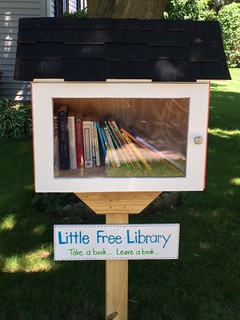 My daughters and I have built a Little Free Library which resides in front of our house. Our neighborhood is slowly embracing the concept, however, the numismatic titles I offered have yet to attract an attention. 'The Coin Collectors Survival Guide' was shelved next to 'Green Eggs and Ham' which is now gone. It now competes with 'Judy Moody Goes to School'. Next week I'll rotate in a 2012 Redbook just to spice things up. Check out
LittleFreeLibrary.org and build your own!
My daughters and I have built a Little Free Library which resides in front of our house. Our neighborhood is slowly embracing the concept, however, the numismatic titles I offered have yet to attract an attention. 'The Coin Collectors Survival Guide' was shelved next to 'Green Eggs and Ham' which is now gone. It now competes with 'Judy Moody Goes to School'. Next week I'll rotate in a 2012 Redbook just to spice things up. Check out
LittleFreeLibrary.org and build your own!
WHAT IS THAT ON THE TURKISH COIN?
Fred Michaelson writes:
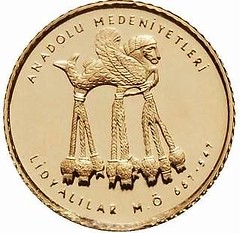 I commend Chip Howell for pointing out the similarity between the Arches National Park Quarter and the R. Crumb cartoon. Being a long-time R. Crumb fan, I'm a bit embarrassed over not catching that myself. Now I'd like to know what Chip's eye comes up with when he looks at the Turkish "first coin" from last week's E-Sylum.
I commend Chip Howell for pointing out the similarity between the Arches National Park Quarter and the R. Crumb cartoon. Being a long-time R. Crumb fan, I'm a bit embarrassed over not catching that myself. Now I'd like to know what Chip's eye comes up with when he looks at the Turkish "first coin" from last week's E-Sylum.
Chip writes:
It took a little searching, but it's a Lydian brooch. The main element is a Hippocampus (horse/fish hybrid), and what trails below are tassles, I guess!
BTW, on the coin, the words ANADOLU MEDENiYETLERi is Turkish for "Anatolian Civilizations" & LiDYALILAR = "the Lydians." I guess the "M. Ö." is their version of "B.C.E." but I don't have my Turkish dictionary with me--it's at work!
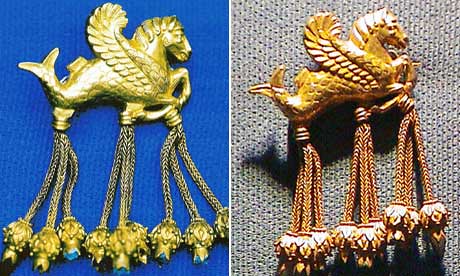
For thousands of years it lay underground, part of the buried treasure of the legendarily wealthy King Croesus. But since being illegally excavated in the 1960s, it has been stolen, replaced by a fake, sold to pay off gambling debts and has allegedly brought down a curse on its plunderers.
Now the 2,500-year-old golden brooch is to be returned home to Turkey, where it will be given a special place in a new national museum.
The Turkish culture minister, Ertugrul Günay, has announced that German officials have agreed to return the missing artefact, a brooch in the form of a winged seahorse, possibly as early as this year.
The brooch is part of the Lydian Hoard, known in Turkey as the Karun Treasure, which was looted from iron-age burial mounds in western Turkey in 1965. The artefacts were sold on, eventually to be exhibited in the New York Metropolitan Museum of Art in the 1980s.
After a six-year legal battle that reportedly cost Turkey £25m, it was repatriated in 1993 and went on display in the Usak museum. But in 2006, after an anonymous tipoff, the brooch on show was discovered to be a fake, with the original missing again.
After an investigation the director of the museum, Kazim Akbiyikoglu, who had been instrumental in recovering the artefacts from the US, was arrested with 10 others. Akbiyikoglu admitted selling museum treasures to pay off gambling debts and was jailed for 13 years. He blamed his misfortune on an ancient curse said to afflict those who handle the treasure.
Popular rumour has it that all seven men involved in the illegal digs of the burial mounds died violent deaths or suffered great misfortune.
To read the complete article, see: King Croesus's golden brooch to be returned to Turkey (www.theguardian.com/world/2012/nov/25/king-croesus-treasure-returning-turkey)
To read the earlier E-Sylum articles, see:
NOTES FROM E-SYLUM READERS: JUNE 22, 2014 : More on the Arches Quarter Design
(www.coinbooks.org/esylum_v17n26a11.html)
SOME RECENT COIN DESIGNS: JUNE 29, 2014
(www.coinbooks.org/esylum_v17n27a22.html)
THE BOOK BAZARRE
MORE DEBATE ON LOOTING AND COLLECTING
Regarding last week's item on the debate on looting and collection, I quoted Paul Barford's blog post Dirty Old Coin Dealings. Paul writes:
You may see nothing wrong with sales of bulk lots of apparently freshly-surfaced paperless dirt-encrusted coins. Nevertheless, when you come across somebody who states why they are an issue, perhaps you could treat it a little more fairly and (a) indent the texts you are quoting, instead of your own "comments" on them to make it clear whose text is where, (b) source the quoted texts properly, giving the author's name by their text, not under your own, (c) NOT sandwich two chunks of somebody else's text together missing out a passage 730 words long with no sign anything has been removed in an effort to make it appear "snarky" and disjointed.
Finally if you are going to tell your readers "what the PAS is" it might be an idea for YOU first to find out what the PAS is and what it is not, what it does and what it does not do. Otherwise you contribute to the superficial and misinformed mythology that passes in US numismatic circles for knowledge. We have more than enough examples of that from the ACCG et al. to welcome any more.
I apologize for confusion regarding the quoted text. The E-Sylum is a hastily compiled informal publication. When we insert quoted text within an article it's usually highlighted and indented as Paul's comments are above. When an article is ALL a quote I often don't bother, highlighting instead only my editorial additions.
The original source of the quoted text is always provided. Here's the link again so readers can review the full text of Paul's blog post at their leisure: http://paul-barford.blogspot.com/2014/06/dirty-old-coin-dealings.html
I never said there's nothing wrong with "sales of bulk lots of apparently freshly-surfaced paperless dirt-encrusted coins." That would raise my eyebrow, too. I said the problem is "the push to assume guilt on the part of a collector who can't prove that his coin WASN'T looted at some point in its 2,000 year history."
I'm not an ancient coin collector, dealer, or metal detectorist, and I don't live in England or Wales, so no one should take my word on the Portable Antiquities Scheme (PAS) as gospel. The web site was our Featured Web Site last week. Readers are again invited to visit it to learn more, straight from the source. Here's the link again: http://finds.org.uk/
In his blog post Paul highlighted how coins unearthed in the UK are handled much differently than elsewhere in the world. Referring to Raz Suarez' Dirty Old Coins web site, Paul wrote:
What are missing from their offer are coins from the UK, where detecting on archaeological sites is legal, objects reported by responsible finders to the PAS and exported (as the law requires) with a UK export licence.
My thesis (which I thought Paul would agree with) is that if the rest of the world were regulated like the UK is, then the illicit looting that neither of us likes would dry up, and dug coins would have a standard, legitimate paper trail through the complete supply chain from the hole in the ground to the holder in a dealer's inventory.
Unfortunately, that would still leave the world with the quandary of how to treat coins that have been in collections for years and never had such a paper trail. Branding them as illegal would be ridiculous.
Through subsequent email exchanges with Paul (a British archaeologist living and working in Warsaw, Poland) it seems he and I can agree on the latter point. He said no one on the archaeology side has proposed that and calls it "yet another of those pernicious straw man arguments coin dealers and their lobbyists throw out to deflect attention from the issues."
I knew I'd be stepping into a buzzsaw by touching on this issue, which I usually avoid like the plague. I was mainly commenting on the tone of the discussion on the archaeology side. In the professionally written Science Daily article Nathan Elkins came across gentlemanly, but 'snarky' was the kindest word I could find to describe Barford's blog, which came across my desk the same week.
Barford's been more reserved in our email exchanges, and I hold out hope that we can one day find some common ground between the two camps. I did have to laugh at the great headline for his follow-up post shredding my lack of editing style, but his tone is unchanged. Good thing I have thick skin. I told him I didn't need to quote selected segments of his post attacking Raz Suarez to present it as snarky. In my opinion, the whole thing was, from start to finish.
To read Paul Barford's blog post, see: "Wayne's Words", or Somebody Else's? (paul-barford.blogspot.com/2014/06/waynes-words-or-somebody-elses.html)
To read the earlier E-Sylum article, see: ONGOING DEBATE ON LOOTING AND COLLECTING (www.coinbooks.org/esylum_v17n27a20.html)
HOW MANY ANCIENT COINS ARE FAKES?
Your article about the looting of ancient coins reminds me of the time I spent three years living in Tunisia in the mid-1970s. I was not an avid collector of ancient coins in those days, but I did like to pick up a couple from the local markets now and then. One time, I was looking through a bowl of ancient coins, all Roman, in a shop and noticed a fairly nice bronze coin. Setting it aside, I kept looking. Soon I discovered about ten coins, just like the first one, but maybe slightly less nice. Comparing them, it became obvious ALL had exactly the same hand-struck flaws. They were modern fakes, but well done. Separately, I would never have known the difference.
Second story: In 1976, I had the fortune to have spent a week working with Dr. Ya'akov Meshorer (on something that had nothing to do with coins). Dr. Meshorer was an archaeologist and a world-recognized expert on ancient coins, both subjects of interest to me. He told me a large percentage of ancient coins on the market were fakes. I asked him how to tell the difference. His main advice was to spend as much time as possible visiting the great museums of Europe and study their coins. After a time, he said, you will learn to see the difference -- it's an acquired art.
Nowadays, with the internet, many of the great collections are available for viewing without going to Europe. I suggest anyone wanting to collect ancients study them first. You will be surprised at what you see. For example, does that sharply-struck ancient coin really resemble any of the coins found in the great museum collections? By that, I am referring to metal wear and flow, rims, sharpness or lack thereof of design, not the designs themselves. I see a lot of material offered by reputable auction houses that I question. On the other hand, I am nowhere near having the expertise of Dr. Meshorer. I just don't buy those items.
This brings up the question the expertise of the U.S. Customs Service in differentiating coins, or even their origin. Could, or has someone gone to jail over a handful of fakes?
To read the earlier E-Sylum article, see: ONGOING DEBATE ON LOOTING AND COLLECTING (www.coinbooks.org/esylum_v17n27a20.html)
MORE ON SIBERIAN MINT MARKS
I would like to thank Steve Bishop for spotting one very embarrassing goof in what I wrote. The regular-design Siberian coppers from 1781-1830 did indeed bear the KM mark, not the CM mark as I had written.
He was correct on the mark, but I maintain he's not correct on the mint.
[I apologize in advance to people who don't specialize in Russian Imperial numismatics; I am going to be throwing even more names you never heard before at you.]
There was never a mint in Kolyvan. I know that many older books, including B. F. Brekke's work on Russian copper coinage (1977, and still the book on Russian imperial copper), make the claim that there was. I believed it myself. But later research has shown this to be incorrect. (I got to modify the text in one of my exhibits as a consequence, between the first time I showed it and the second time I showed it.)
An article in the Summer 2003 Journal of the Russian Numismatic Society, authored by V. V. Uzdenikov of the Hermitage and translated into English, brings out the following.
1) The letters KM appearing on the Siberian-design pieces are not a mint mark. The evidence, document 121, as reproduced in Grand Duke Georgi Mikhailovich's Corpus volume on the coinage of Catherine the Great (hereafter: GM): "It is noted that the letters K.M on the ten [kopek] coin have the same meaning as the edge legend, i.e., Kolyvanskaya Med.' [Kolyvan copper.]" I should note that this is a quotation from a contemporary document reprinted in the Corpus (herafter, I will call it "GM.") Further--the edge inscription only appeared on pieces that have no KM mark, and vice versa. (Pieces smaller than 5 kopeks never had the edge inscription, but the KM letters were first used on original coinage in 1767. 1766-dated pieces with KM are novodels.)
2) There was no mint at Kolyvan; the mint was at Suzun, and was always at Suzun. Document 129 from GM indicates that the Siberian coinage was minted at a facility constructed in Suzun. Furthermore, Uzdenikov's 1992 general reference lists no mint in Kolyvan, neither does his book on the various Russian mints from 1995 (which as far as I know only ever appeared in Russian). Further indications come from (you guessed it) GM, this time document 129, which states that the Siberian coinage were constructed at a facility built in Suzun. (I was able to verify that the word Suzun appears in this document; but my Russian isn't good enough to be able to translate it, nor is the scan I have of that page of GM very legible in any case.)
For reasons I don't understand, the Suzun mint continued to mark its coins with the letters KM even after it began producing regular-issue coppers in 1781 (as Steve pointed out). It finally changed over to CM in 1830, and the mint was finally shut down in 1847. Uzdennikov, in his 1992 reference, on pages 607 and 615 gives conflicting information on whether "KM" during this time period stood for "Kolyvan Copper" or "Kolyvan Coin." The latter would be a mint mark. Nevertheless, Uzdennikov insists in both of the works that I've mentioned that the mint was physically in Suzun, and is identical to the mint that used the CM mint mark from 1830 to 1847. Brekke mentions the "Kolyvan" mint having a fire during its initial construction, but (as it turns out) archival sources show that the fire was in fact at the Suzun facility! (Note: Uzdennikov's earlier edition from 1985 does indicate a Kolyvan mint operating from 1766 to 1801 [huh. Not 1830?], pages 448-449. Obviously he changed his mind.)
OK, so why the confusion? I don't know for sure but I speculate that it stems from the fact that the Russian words for copper and coin both start with M. KM (standing for Kolyvanskaya Med') looks just like a mint mark. Indeed other contemporary coppers have marks like EM, AM, TM, MM and CM.
As an aside, a different oft-repeated misconception that is also corrected in that same Summer 2003 JRNS article is that the copper was from a copper mine that had traces of silver and even gold in its ores; in fact the copper was byproduct of a silver mine, as I indicated.
[In case anyone is wondering, A, T, M, and K in the Cyrillic alphabet are pronounced the same as in ours (though A is always "Ah", unless it's in an unstressed syllable, and never like the "long a" in "cake"). The C is pronounced like an S, always (unlike our C which might be pronounced like K), and the E is pronounced "Yeh" when it appears at the beginning of a word like "Ekaterinburg" but is roughly cognate to our "E." So the letters are pretty close to meaning what they look like they mean to our Western eyes.]
To read the earlier E-Sylum articles, see:
THE FT. ROSS, CALIFORNIA SOUVENIR TOKEN
(www.coinbooks.org/esylum_v17n25a16.html)
MORE ON THE FT. ROSS, CALIFORNIA SOUVENIR TOKEN
(www.coinbooks.org/esylum_v17n26a17.html)
NOTES FROM E-SYLUM READERS: JUNE 29, 2014 : Siberian Coin Mintmarks
(www.coinbooks.org/esylum_v17n27a08.html)
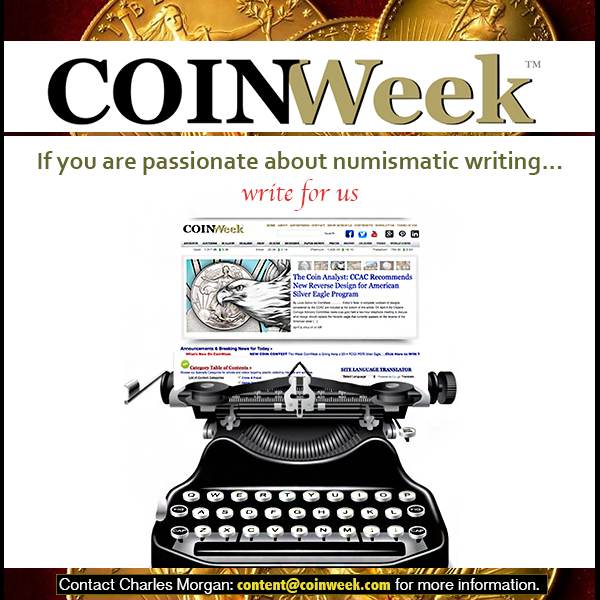
1755 DRURY LANE THEATRE ROYAL PASS
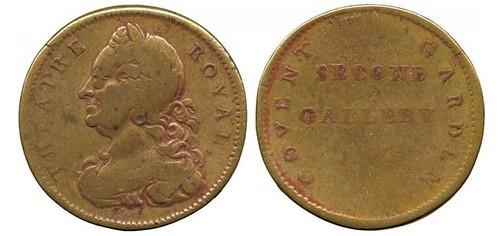
Great Britain, London, Covent Garden, Drury Lane, George II, Brass Ticket or Pass for the Theatre Royal, dated 1755, by J Kirk, obverse: bust of King George II to left, THEATRE ROYAL around, beaded border around all, reverse: SECOND GALLERY in two lines, date below, COVENT GARDEN around, edge plain, 30mm. The first theatre on the location was destroyed by fire in 1672. Thomas Killigrew built a larger theatre in the same spot, designed by Sir Christopher Wren which opened in 1674. This building lasted nearly 120 years, under leadership including Colley Cibber, David Garrick and Richard Brinsley Sheridan. The great Ulster Shakespearian actor Charles Macklin performed in this building. In 1791 the building was demolished to make way for a larger theatre which opened in 1794 (Davis & Walters 12/112). Well used, fine and very rare.
To read the complete article, see: Drury Lane, Theatre Royal Pass 1755, rare (www.baldwin.co.uk/tokens/drury-lane-theatre-royal-pass-1755-rare.html?usrc=1)
In the attic room through 18 September is "Behind the Scenes", an exhibit on Georgian Theatres 1737-1784. In one case was a Shakespearian Jubilee Medallion, a silver medal struck in 1769 to "commemorate the Jubilee organized by David Garrick in Stratford- Upon-Avon to celebrate the bicentenary of Shakespeare's birth. The medal was displayed with its original hanger, ribbon and box.
In another case was a group of 1778 Haymarket entry tokens. These were used as admission tickets to the Haymarket Theatre. The four apparently polished tokens were encased in Lucite. Their inscriptions included the words "Box", "Pit", "First Gall'y" and "Second Gall'y". The exhibit text explained that Boxes were for people "of quality". The Pit was for "ladies, gentleman and intellectuals." The First Gallery was for "tradesmen and their wives" and the Second Gallery was for "the mob."
Finally, a third case contained another unusual numismatic item: "John Philip Kemble's 'George'", a crude-looking medal of "silver or nickel alloy c1781-1817." The text explained that "A George Medal was "... traditionally worn onstage by actors in the role of Richard III; it depicts George slaying the dragon'.
To read the earlier E-Sylum article, see: WAYNE'S LONDON DIARY 11 AUGUST, 2007: SAMUEL JOHNSON'S HOUSE, ST. PAUL'S (www.coinbooks.org/esylum_v10n32a18.html)
THE NEW HAMPSHIRE FEMALE CENT INSTITUTION

The New Hampshire Female Cent Institution and Home Missionary Union was chartered under that name on March 4, 1891. Earlier known under various names including the New Hampshire Female Cent Institution, the Female Cent Society, and the Female Cent Society with various town names as prefixes. It is thought to have been established in 1804 and had its first full year of operation in 1805, when receipts totaled $5. There were Female Cent Societies in other states, possibly dating back to circa 1800.
The name was based on female churchgoers, mostly Protestant, donating one cent per week to missionaries who spread the word within the United States.
I wonder if the cut of the 1804 cent can be attributed to some book? I would guess that the cut is from some publication—not made by the Society—and it could be tracked down.
Harry Salyards writes:
Interesting question, Dave. The series in the Coin Collectors Journal only illustrated changes in major design types—thus, the 1796 Draped Bust in the 1880 volume, page 50, and the 1808 Classic Head in 1881 page 18. The date is much closer to accurate, in style, than the illustration in Doughty (1890, p. 97)—but the engraver not only put serifs on the 4 (correct) but on the head of the 1, like an 1803 Large Date (incorrect).
MORE ON 1863 CSA INGOTS
Regarding 1863 CSA Ingots, web site visitor John Tomlinson writes:I am an avid metal detector user. I found four of these ingots on the site of a Civil War fort. In the same area we found a period belt buckle, musket trigger assembly, buttons and musket balls. The ingots I found are in pretty rough shape compared to the ones you have pictured. I have had them tested and they are silver.
The location where the Confederate fort stood has now been developed. The area has been developed for over a century. Concrete was being torn up and we went out and searched the area. I am going to respectfully decline to divulge the location. My state is notorious for taking custody of historical artifacts found on public land by hobbyists.
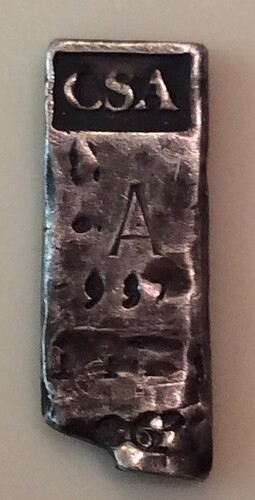
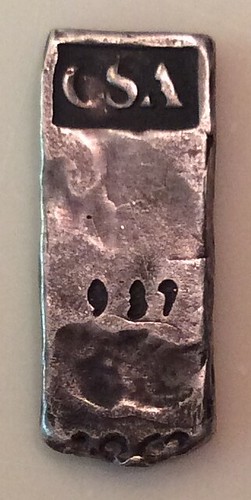
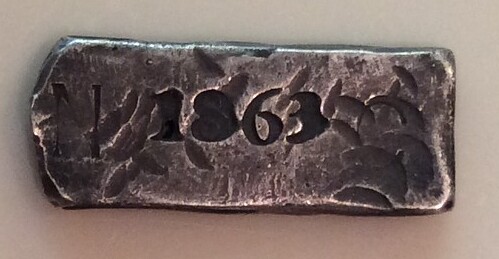
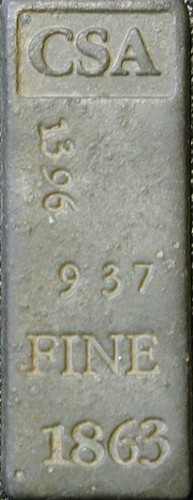
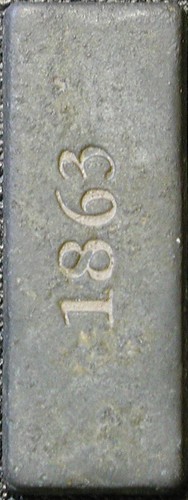
Images provided by Paul Horner


Images provide by Harold Levi
To read the earlier E-Sylum articles, see:
QUERY: CSA SILVER INGOT INFORMATION SOUGHT
(www.coinbooks.org/esylum_v11n50a21.html)
MORE ON THE CSA SILVER INGOTS
(www.coinbooks.org/esylum_v11n52a07.html)
THE BOOK BAZARRE
SLACKING AT WORK, MAKING COUNTERFEITS
From Tom DeLorey (with regards to last month’s article of counterfeit dimes):
As to the economic viability of making counterfeit dimes for circulation, I would suggest that many of them were made in metal-working shops that already had the equipment necessary to do so, so they would not require an investment in equipment that would increase the cost of each counterfeit.
And, it is quite possible that the counterfeits were made by employees of such metal-working shops without the knowledge of the lawful proprietor. By stealing materials, time and the use of equipment the counterfeiter can actually achieve 10 cents profit on a counterfeit dime, if he can pass it.
Ed Fleischmann, my mentor at Coin World and one of the earliest members of the LSCC, once told me a story about having some guy he knew there in Sidney, OH showing him a cast aluminum 1964 Kennedy half dollar. He told the guy that was illegal, and the guy said, no, no, he wasn't going to spend it, he just wanted to see if he could do it. Then one ended up in the cash register of a local bar.
There were two aluminum foundries in town at the time. A Secret Service agent visited the President of each, showed them the coin, and told them that when they figured out which one of them made the coin they were going to shut the foundry down.
For more information on the LSCC, see: www.lsccweb.org
THE NUMISMATIC CONTRIBUTIONS OF BOB EVANS
 Robert J. Galiette has been an E-Sylum subscriber since about 2000, and I finally had a chance to meet him in person at last week's Whitman Baltimore Coin Expo. I learned we have a mutual friend in Bob Evans, the history and numismatic expert for the organizations salvaging coins and bullion from the wreck of the S.S. Central America. Bob's study of the historical record and passenger accounts of the wreck helped guide the crew to the location of the site in the 1980s. As material was brought up from the ocean floor he painstakingly catalogued and later conserved and documented every last item. Earlier this year Bob set sail for a return trip to the site, where additional artifacts are being retrieved from the wreck site.
Robert J. Galiette has been an E-Sylum subscriber since about 2000, and I finally had a chance to meet him in person at last week's Whitman Baltimore Coin Expo. I learned we have a mutual friend in Bob Evans, the history and numismatic expert for the organizations salvaging coins and bullion from the wreck of the S.S. Central America. Bob's study of the historical record and passenger accounts of the wreck helped guide the crew to the location of the site in the 1980s. As material was brought up from the ocean floor he painstakingly catalogued and later conserved and documented every last item. Earlier this year Bob set sail for a return trip to the site, where additional artifacts are being retrieved from the wreck site.
Rob's Gilded Age Collection of Double Eagles, which includes some great pieces from the S.S. Central America trove, will soon come up for auction at Stack's Bowers Galleries. He submitted the following thoughts for E-Sylum readers on Bob's contributions to numismatics. Hear, hear! -Editor
I’ve wanted people to understand how great a contribution Bob Evans has made to numismatics. He wrote some beautiful segments to the forthcoming Gilded Age Collection auction catalog by Stack’s Bowers, and wanted to contribute more, but he’s at sea with a 9pm to 9am shift every day, and he’s working virtually round-the-clock seven days a week there.
However, the entire hobby benefits from the valuable coincidence that Bob happened to live near Tommy Thompson in Ohio, and that a quarter of a century ago, over a six-pack as Bob has described it to me, Tommy recognized Bob’s special training and experience. Bob’s college education is as a scientist studying fossils through microscopic examination, and he trained with some of the best experts in the world.
Bob was able to apply his experience and education to use university library resources in Ohio to develop near pH-neutral solutions that could be prepared in batches and used at sea, where rocking and rolling on a ship otherwise would have created problems with harsher material to remove surface encrustations from coins -- which are deposits on a coin’s surface, versus actions that affect tarnish or toning, which are chemical reactions to a coin’s surface.
Bob’s contributions are all the greater when someone realizes that, as Dave Bowers reminds people, there’s no evidence of anyone saving and collecting circulation strike and branch mint double eagles during the early years when they were produced. The only way that Liberty Head double eagles were collected at all was as part of 6-coin and later 4-coin gold Proof sets. However, between 1859 and 1880 as few as only 20 to 30 Proof $20’s were coined in some years, and unsold Proofs either were placed into circulation or remelted. Dave Akers estimated that only 7 to 10 Proofs survive for some of these early years. A few $20 Proofs were produced in 1858, but only 3 or 4 are known.
Therefore, Bob’s careful methods secured for the hobby Type 1 $20’s from 1857 and earlier in numbers and in grades for which it had seemed no survivors ever would have been available. For example, 1857-S $20’s have become available in grades up to MS67 -- previously unheard-of for a Type 1 $20, and only recently collectable in that grade over a century-and-a-half after their production. The 1854-S S.S. Central America $20 in the Gilded Age Collection was the finest obtained from the San Francisco Mint’s first year of operation, and the lowest Liberty Head double eagle production year at that facility. It also may be one of only three mint state 1854-S $20’s not recovered from the S.S. Yankee Blade, which sank after hitting a submerged reef. Coins from the Yankee Blade have markedly etched or sandblasted surfaces as a result of sand and currents sifting over them for more than a century at the shallow depth of the shoals where they were located.
Thinking of Bob’s background and mine, people were joking in January at the F.U.N. show that a micropalenotologist and an immunopharmacologist were working to develop double eagle collecting.
However, we’ve been happy to bring attention to a series that never has been collected like any other type of United States coins. Up to this time, double eagles, if they were collected at all, were assembled as mixed agglomerations of a few Proofs with a few Mint State coins, and with a majority of worn circulation strikes comprising the bulk of a respective collection. The four greatest gold collections of Bass, Browning, Eliasberg and the Smithsonian’s National Numismatic Collection, for example, if put together have 114 different Mint State Liberty Head double eagles. The Gilded Age Collection has 122 different Mint State $20 Liberties (plus another 40 St. Gaudens $20’s) and is impressive to see in one group because of the similarity in appearance of the coins.
We’d like to inspire collectors to go beyond the mere numbers on plastic holders used to form registry sets, and pursue pure numismatics. There are many new horizons for collectors to reach. For example, after more than a century after Liberty Head double eagle production ceased in 1907, this is the first collection at auction to have a Mint State San Francisco Mint $20 Liberty for each of the 53 years in which a Liberty Head double eagle was produced there. Even more remarkable is that 150 years after their production, this is the first collection at auction to have even the ten paired P and S-Mint Civil War year 1861 through 1865 $20’s in Mint State.
I’d like to see someone add an 1886 $20 circulation strike in Mint State and be the first person in numismatic history to have a Mint State year set of all 58 consecutive years of Liberty Head double eagle production from 1850 through 1907 inclusive. There are at least three certified Mint State 1886 $20’s, but after two decades of searching I couldn’t find one. One of the last offered at auction was in a combined Stack’s and Dave Akers auction in 1988.
Similarly, if someone added an 1871-CC and an 1872-CC $20 in Mint State, it would produce the first collection to have all known certified Type 2 1866 through 1877 $20’s in Mint State (there being no known certified Mint State 1870-CC $20 at this time). The addition of an uncirculated 1859-P $20 would produce the first group of all paired Type 1 $20’s in Mint State. The Battle Born Collection auctioned in August 2012 was the first to have all known certified Mint State Carson City $20’s in one group.
People don’t have to think wistfully about what it was like to have been in numismatics a century ago in Farran Zerbe’s time. They can be persons of their own time -- go to the ANA, talk to someone like Dave Bowers, have him and others sign their book and auction catalog or, if so disposed, buy a coin plated in the book and have the page autographed. Some Mint State coins in the later Type 3 $20 years sell for only a small amount over bullion, which at the moment also has had a favorable buyer’s dip. Dave thinks that this year’s book, U.S. Liberty Head $20 Double Eagles: The Gilded Age of Coinage, is the most beautiful book that he’s written. In view of his unparalleled authorship, it’s a statement that keeps us motivated and focused in any associated work we do.
Bob writes:
With regard to the kind words you had about my work with Type I double eagles, "Aw shucks."
I hope that my enthusiasm for the subject shows through my work. My unique good fortune at being involved in the discovery of the greatest source of these magnificent coins, in a scientific sense the largest "sample," has afforded me an opportunity that is truly a dream come true.
It was also a great opportunity to be invited to examine the Gilded Age Collection and to submit some selected observations for the catalog. A particular joy was to run into an old friend again, the mint state specimen of 1854-S $20 that I distinctly remember finding in my conservation lab fourteen years ago.
If anyone is wondering, we on board the Odyssey Explorer rode out Hurricane Arthur by transiting further out to sea, allowing the storm to pass, then getting right back to the job at hand. We have a sturdy ship and crew, and everything is fine here.
Anyway, my best to you, Rob, and all my E-Sylum friends.
A. CHARLES GIES, NUMISMATIST
A. Charles Gies was a jeweler and optician, who began collecting coins in 1864. In a letter contained in the WPNS archives, he recalled the beginnings of his collection of "the war tokens and store cards of Pittsburgh." Gies stated that he "started to collect these momentoes of our Early Store Keepers when small change was very scarce. I knew where all these stores were. (I) was in some of them when I was a boy, and in after years got acquainted with some of those that issued these coins during the period of the Civil War, among which I mention Mr. Buffum."
Gies had built a collection of 95 varieties of Pittsburgh Civil War store cards in copper, brass, white metal, nickel, and paper.
Gies was elected a trustee of the A.N.A. in 1904. He attended the Chapman's Stickney sale in Philadelphia (June 25-29, 1907), taking a trolley excursion to Fairmont Park one evening with Dr. Louis Comparette of the Philadelphia Mint, Virgil Brand, Ben Green, Thomas Elder, Edgar H. Adams, Farran Zerbe, and others. In September of that year Gies joined 27 fellow numismatists for the A.N.A. Convention in Columbus, Ohio. He is pictured in the front row of the official convention photograph, along with Heath, Zerbe, Green, Elder, and S.H. & H. Chapman. Gies brought with him an 1816 half dollar, which he sold at the convention.
It was reported in the October 1911 Numismatist that while on a trip through the Rocky Mountains Gies acquired an 1861 Parsons & Company $5.00 gold piece (only 4-6 pieces are known today).
Gies collected all U.S. coins, but specialized in half dollars, discovering many die varieties not listed in the standard reference of the day, the Haseltine Type Table catalogue.
As reported in The Numismatist, Gies attended the 1924 Cleveland A.N.A. convention, where he and fellow Pittsburghers (and WPNS members) Gottlieb Kraft and Perley W. Locker "were inseperable conventionites. They are a long-time friendly trio of rivals for die varieties of the early United States half dollars. What they did not have on public display they had to show in private. Based on their combined table of varieties, a new 'type table' is in order."
George Clapp, in a letter to the Society written July 2, 1938 (in response to a letter notifying Clapp of his nomination as an Honorary member) stated "this is an unexpected honor and while I am the only living "Charter Member" I feel that the honor should have gone to "Charlie" Gies, the man who has held the Society together, and done the real work, in doing so, these past sixty years." At the time his half dollar collection was auctioned by Stack's in 1940, Gies was the oldest living collector in the United States.
WPNS member Larry Dziubek writes:
A.C. Gies is a real hero. Did you ever see a listing or catalog of a sale of his Pittsburgh Civil War Tokens? I am especially interested in names of issuers of the paper/cardboard items.

DIGITIZE YOUR BOOKS FOR $1 EACH
I subscribe to Dick Eastman's daily genealogy newsletter (I don't know how folks like you and he can do things like this, but I sure appreciate that you do) and today he had an interesting bit:
Scanning a book is a tedious process, and I haven’t completed the scanning of very many books. One online service promises to do the job at a modest price: one dollar per 100 pages. The same service will also scan documents, photographs, business cards, and even the old greeting cards from relatives that I have been saving all these years.
 1DollarScan has been in business for a few years and has a good reputation. Anyone can use 1DollarScan by filling out an online order form and then shipping the books or other materials to 1DollarScan’s offices in San Jose, California. The company scans them and converts them into PDF files and also (optionally) performs OCR (optical character recognition) to create a text layer behind the images, which makes the text searchable and selectable. The PDF files and text files can be sent to the customer by download or on DVD disks.
1DollarScan has been in business for a few years and has a good reputation. Anyone can use 1DollarScan by filling out an online order form and then shipping the books or other materials to 1DollarScan’s offices in San Jose, California. The company scans them and converts them into PDF files and also (optionally) performs OCR (optical character recognition) to create a text layer behind the images, which makes the text searchable and selectable. The PDF files and text files can be sent to the customer by download or on DVD disks.
After 1DollarScan has scanned the materials and returned the electronic images to the customer, the original paper documents may either be returned (the customer pays the shipping charges) or sent to a recycling service to be shredded and reborn as recycled paper. Obviously, none of us will be sending family heirloom photos to be recycled! For me, this is a great method of recycling all the less-valuable books and magazines I have accumulated over the years. I bet I have 200 pounds of them, and I certainly can’t keep them all when I downsize my living space.
One question that pops to mind is, “What about legalities?” Indeed, the folks at 1DollarScan have examined the issue closely and have obtained legal advice. The company’s managers seem confident that the conversion service does qualify as “fair use” although others, including the Author’s Guild, disagree. The Author’s Guild position is outlined in an article in Publishers Weekly at http://goo.gl/XHOvXr. The attorney for 1DollarScan also is quoted at the end of the same article. The 1DollarScan attorney’s position is that making a backup for personal use is a classic fair use of a work you own, similar backing up your CDs to play later on your MP3 music player. The concept of converting music CDs you already own to another format has already been tested in court and has always been deemed to be legal, at least in the United States.
In short, 1DollarScan does not make copies. Instead, it makes conversions. The customer gives up the original book in order to obtain a PDF version. I am not an attorney, so I cannot guess at the complex legal issues involved. However, I suspect it will be difficult to convince most judges that 1DollarScan is committing copyright infringement by converting a customer’s books and documents from one format to another. It should be interesting to watch this issue if it ever does wind its way through the courts.
It appears that the primary business of this company is newer books and magazines, but just the other day I was visiting with John Byars who remarked that he had a Texas Gazetteer from the 1890s that he would love to be able to search electronically. This sounds like a solution, but the downside is that they saw the binding off the book to allow the individual pages to be scanned. If it were my gazetteer, and if they would return the stack of original pages, I'd have to give this some serious thought.
After glancing over a couple of hundred books on my shelves, the only ones I would feel comfortable destroying in exchange for an electronic (searchable) version are the city directories, gazetteers, and Dun & Bradstreet-type business directories that I use in researching tokens. I might even go for the local and county history books I have which have no indexes. But beyond those, I'll keep my physical books, thanks.
To read the complete article, see: Scan and Digitize Your Books for $1 Each (blog.eogn.com/2014/06/29/scan-and-digitize-your-books-for-1-each/)
For more information, see: 1dollarscan.com
NLG NEWSLETTER GOING ALL-DIGITAL
Ed Reiter wrote:
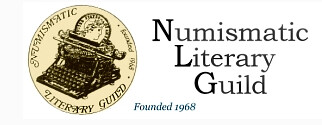 The next NLG Newsletter will be the last one published and distributed in printed form. Thereafter, the Newsletter will be available only in an electronic version at our Internet Web site, nlgonline.org.
The next NLG Newsletter will be the last one published and distributed in printed form. Thereafter, the Newsletter will be available only in an electronic version at our Internet Web site, nlgonline.org.
We have been considering this change for several years, but have deferred it because we felt some members might not have Internet access. At this point however, we're satisfied that virtually all members of the Guild make use of computers.
The change will enable us to post information and photographs more regularly and in a more timely manner.
For more information on NLG, see: www.nlgonline.org
STACK'S BOWERS TO OFFER GARRETT 1804 DOLLAR

The Berg-Garrett Class III 1804 Dollar highlights Rarities Night
Stack’s Bowers Galleries is thrilled to present the “King of U.S. Coins,” during our Rarities Night Session of the Official ANA World’s Fair of Money Auction on the evening of Wednesday, August 6. This example of the extremely rare 1804 dollar, struck circa 1859, and pedigreed to 1875, will create quite a stir and attract much bidder activity. The expert description by Dave Bowers and Frank Van Valen is quoted in its entirety, and we hope you enjoy getting this early preview of this extremely important rarity. This is a very important opportunity for collectors, and even if an 1804 is not in your collecting budget, be sure to view this coin during lot viewing at our offices in Irvine or New York, or at the ANA convention.
“In all the history of numismatics of the entire world, there is not today and there never has been a single coin which was and is the subject of so much romance, interest, comment, and upon so much has been written and so much talked about and discussed as the United States silver dollar of 1804.
“While there may be coins of greater rarity (based upon the number of specimens known), none are as famous as the dollar of 1804! This is due to the fact that this great coin was the first coin of United States mintage to have been recognized as the rarest coin of the United States, from the very beginning of American numismatics, more than one hundred years ago. And it is today, as it always has been, the best known and most sought-after coin, not only among collectors, but among the public in general as well.”
B. Max Mehl
1941
There are rarer coins, but in the federal series there are none that challenge the fame, tradition, and glory given to the 1804 silver dollar over a long period of years. In 1941 B. Max Mehl called it “The King of American Coins,” and it still commands that position on the numismatic throne.
Over a long period of years it has been our pleasure to have handled most of the 1804 dollars in existence, from the population of 15 coins totally. Eight Class I dollars are known, one Class II (in the National Numismatic Collection in the Smithsonian Institution), and six of the Class III, including the presently offered coin. Each of our past offerings has created a sensation. The ownership of an 1804 dollar places the buyer in a Pantheon of numismatic fame.
“Three times is a charm” goes the old saying, and for us, the saying never rang more true. This is the third time we’ve had the honor and distinct pleasure to present the Berg-Garrett 1804 dollar to the collecting public. It first appeared in our sale of Part II of the Garrett Collection in March 1980 – that was its first appearance in the numismatic marketplace in 97 years! Now this great treasure marks its first appearance in the public eye since Mrs. Laura Sommer added it to r collection in 1986 just after its appearance in our Harry Einstein Collection in June of that year. Now it is 28 years later and the coin returns to thrill yet another generation of collectors.
Among the great and popular rarities that dot the American numismatic landscape, there is a small group that have been written about time and time again, but deservedly so – the 1804 dollar, the “King of American Coins,” is one of those coins. Indeed, no offering of an 1804 silver dollar would be complete without a background story, as its history is filled with colorful figures and smacks of the inner workings of the Mint in early to mid-19th century America.
To read the complete article, see:
The King of U.S. Coins to Cross the Auction Block at the Stack’s Bowers Official ANA Auction
(www.stacksbowers.com/NewsMedia/Blogs/TabId/780/ArtMID
/2678/ArticleID/64596/The-King-of-US-Coins-to-Cross-the-Auction-Block
-at-the-Stack%E2%80%99s-Bowers-Official-ANA-Auction.aspx)
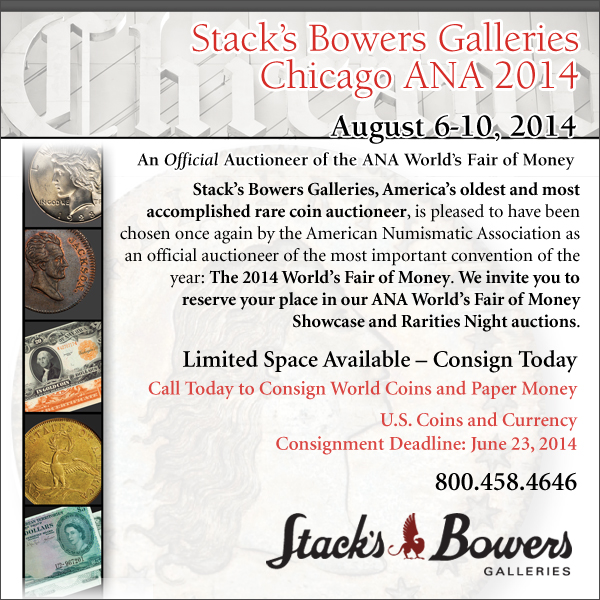
1865 EGYPTIAN SUEZ CANAL WORKERS TOKEN

The weekly iAuctions here at Stack’s Bowers Galleries are a great source for collectible coins within a reasonable budget. Every month (closing on the first Sunday of the month) these iAuctions will contain World and/or Ancient coins, with the inclusion of some very notable highlights such as this piece, a historically important coin involved with the construction of the Suez Canal. Located in Egypt, the Suez Canal allows naval vessels and merchant ships to easily cross between the Mediterranean Sea and the Red Sea. A revolutionary feat of engineering, it allows for a much shorter route between Europe and East Asia, without navigating around the entire continent of Africa.
The French oversaw the ten-year construction, with much interference from the British. These tokens were issued for use by the Egyptian workers who were building the canal. The long rivalry between the French and British interests in the canal led to the debacle once the canal opened in November 1869. The Egyptian leader granted the French Empress Eugenie in the Imperial yacht Aigle the inaugural passage through the canal. However, the night before the canal was due to open the British captain George Nares navigated the HMS Newport, in total darkness and without any lights, through the mass of ships waiting to pass through and usurped the front position just before the Aigle. Nares maneuvered his ship so that the French could not pass him, and became the first ship through the canal. The French and Egyptian officials reprimanded him, but he received an unofficial vote of thanks from the British Admiralty for promoting British interests and demonstrating excellent seamanship.
The coin we have on exhibit is the smallest denomination for this company’s series, the brass 20 Centimes. This particular piece was issued by the “Borel Lavalley at Cie” Company. The obverse design is dominated by a ship at sea with multiple masts and sails, within a beaded border. The French inscription surrounds the border, “TRAVAUX DU CANAL DE SUEZ” – “Work of the Suez Canal”, with “EGYPTE” appearing below. The reverse designates the company, date, and denomination, as follows: “BOREL LAVALLEY ET COMPIE” (the issuing company) above, 1865 below. Within a beaded border, “BON POUR 20 CENTIMES” appears with two stars, and designates the denomination.
To read the complete article, see:
Historically Important Egyptian Suez Canal 20 Centimes
(www.stacksbowers.com/NewsMedia/Blogs/TabId/780/ArtMID/
2678/ArticleID/64599/Historically-Important-Egyptian-Suez-Canal
-20-Centimes.aspx)
RUSSIA TO ISSUE CRIMEA BANKNOTE
Russia plans to issue a banknote dedicated to Crimea, a senior Central Bank official said Wednesday, the latest show of national pride over Moscow's annexation of the Black Sea peninsula from Ukraine.
"We plan to issue a banknote dedicated to Crimea, but it will be a banknote of the denominations already in circulation," Georgy Luntovsky, the regulator's first deputy chairman, told journalists at a banking conference in St. Petersburg.
Luntovsky said he hoped the banknote would be issued by the end of the year but gave no further details.
It was not immediately clear what the Crimea banknote would look like, though a Russian politician earlier suggested it should depict monuments in Crimea, including those in Sevastopol where Russia's Black Sea Fleet is based.
To read the complete article, see: Crimea-Themed Banknote to Appear in Russia (www.themoscowtimes.com/business/article/crimea-themed-banknote-to-appear-in-russia/502865.html)
NUMISMATICS AT BURG CASTLE
 Here we would like to introduce you to the numismatic side of Burg Castle on the Wupper river, family seat of the County of Berg.
Here we would like to introduce you to the numismatic side of Burg Castle on the Wupper river, family seat of the County of Berg.
At some point during the 11th century, a noble family managed to establish itself as counts ‘del Monte’, of the caste. They built their castle on the Wupper river around 1150, according to archaeological testimonies.
The most famous count of the house of Berg was Engelbert II that held a churchly office, like many younger sons.
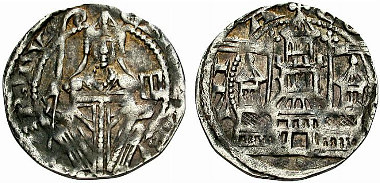
Engelbert I of Berg, as Archbishop of Cologne, 1216-1225.
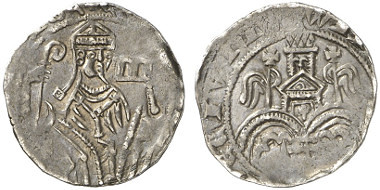
County of Berg. Adolf V, 1259-1296. Pfennig, Wipperfürth.
Since the 19th century, the Bergisches Land has a great tourist attraction - Burg Castle that also has some numismatic goodies to offer.
First of all, there is a hoard that was discovered during construction works at Burg Castle in 1952. It is tempting to link the 508 medieval denarii with one of the lords of the castle – after all, Count Adolf III had died in the crusade in Egypt in 1218. So he was denied any chance of retrieving his coins ever again. But the not quite so romantic numismatists point out that the 508 pfennige cannot be considered a princely fortune and, consequently, this hypothesis has no basis in fact.
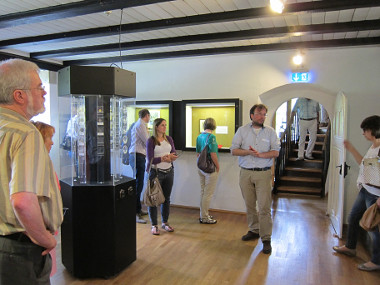
The Coin Cabinet.
There is likewise a coin collection at Burg Castle, albeit it only consists of the poor remains of the old collection and some acquisitions of recent. The impressive collection of the 19th century was destroyed in a fire and in its aftermath, respectively. But still, there are some things to marvel at, in this hall.

Klippe coins, minted during the siege of Jülich.
To read the complete article, see: Numismatics at Burg Castle (www.coinsweekly.com/en/News/4?&id=2861)
THE BOOK BAZARRE
BEP ANNOUNCES CURRENCY READER FOR THE BLIND
The Bureau of Engraving and Printing (BEP) revealed today its plans to distribute currency reader devices at no cost to eligible blind or visually impaired persons, as one component of its initiative to provide meaningful access to Federal Reserve notes (U.S. currency). Program details were presented at the National Federation of the Blind’s (NFB) Board of Directors meeting and annual convention by the Senior Advisor to the BEP’s Director, Dawn R. Haley, in Orlando, Florida.
Haley signaled the U.S. Currency Reader Program kick-off by announcing that currency readers would be distributed to eligible attendees at the July and August summer conventions of the National Federation of the Blind, American Council of the Blind (ACB), and Blinded Veterans of America (BVA), followed by a broader launch of the program in two phases.
“The BEP has participated at the summer conventions for a number of years now,” Haley said. “We are excited to introduce our currency reader program plans here at this venue and to provide currency readers to interested conference participants here and at the other conventions as well.”
Through a national network of cooperating libraries, NLS administers a free library program that circulates braille and audio materials to approximately 400,000 eligible borrowers in the United States. “The fact that we already have a process in place to provide reading materials to individuals who are blind or visually impaired made our partnership with the BEP a natural fit,” explained Isabella Marques de Castilla, NLS Deputy Director. “Our role in the U.S. Currency Reader Program will be to process orders and distribute currency reader devices to eligible individuals.”
In 2011, the BEP introduced EyeNote®, an app that scans and identifies note images on mobile devices operating on the Apple iOS platform. A similar app for Android phones, the IDEAL Currency Reader ® was developed through collaboration with the Department of Education.
Individuals interested in applying for a currency reader device or learning more about BEP’s meaningful access program can visit www.bep.gov.
To read the complete press release, see: BEP Announces U.S. Currency Reader Program for Blind and Visually Impaired (www.bep.gov/images/Press_Release_US_Currency_Reader_Program.pdf)
LEUVER ON CURRENCY READERS FOR THE BLIND
At the bureau, our concern and conclusion was always that tactile features will wear off of U.S. currency, defeating the tactile benefit for the sight-impaired.
Experience. As BEP director I was in Europe. I returned and was told that I was to speak four days later to a major convention of the eyesight-deprived in Las Vegas. Yes, Las Vegas! I spoke in a cavernous somewhat low-ceilinged hall. There was a good turn-out for an early morning talk. The BEP had not addressed any tactile markings to aid the blind. All we discussed was the Canadian endeavor to use a pocket machine to determine currency value, but not authenticity.
The good people who breakfasted early to listen to me were highly upset--and, in retrospect, disheartened, to hear me state the only available solution to determining the value of a US banknote was a pocket held machine. The resounding chorus was, "We do not need another machine to lug around!"
I could not agree more. But our immediate concern at the BEP was to get Treasury approval for counterfeit deterrence, specifically, thread, color shift and a larger portrait. Color was vetoed, much to the consternation of the Fed (Federal Reserve). The Fed thought I was a traitor to the cause--and, to some extent the fellows from the Secret Service, who were working on the Task Force--chaired by the US Treasurer.
Background. This will be the most interesting aspect of the BEP decision, investment and PR. "Another machine to lug around."
There are so many exciting and excellent machine readable features to US currency wherein a relatively small machine or smart phone app will detect instantly the value and authenticity of US currency. Small machines or cell phones are so commonplace today and readily available and useable by the sight-handicapped. I would think these facts would weigh in any decision at the BEP.
Tactile features are limited and relatively easy to compromise. A counterfeiter could easily reproduce tactile features of high denomination notes to the financial loss of a sighted-handicapped vendor or businessman.
Disclaimer: I am an advisor to Reconnaissance International LTd. (Sunbury-on-the-Thames, UK) "Authentication News". Reconnaissance specializes in publishing newsletters, sponsoring conventions and meetings, and consultation re the security for printed currency and documents, products (especially pharmaceuticals), and trademarks. I am not an expert, but am knowledgeable about the technical innovations regarding taggants and authentication features.
ACADEMY SUES OVER AUCTIONED OSCAR
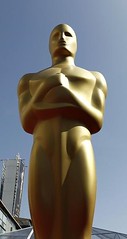 The organization that hosts the Academy Awards has sued over the recent auction of a 1942 Oscar awarded to the art director of "My Gal Sal" and is seeking to buy back the statuette for $10.
The organization that hosts the Academy Awards has sued over the recent auction of a 1942 Oscar awarded to the art director of "My Gal Sal" and is seeking to buy back the statuette for $10.
The Academy of Motion Picture Arts and Sciences filed the lawsuit Tuesday in Los Angeles County Superior Court against Rhode Island-based Briarbrook Auction Services.
Briarbrook sold the Oscar for $79,200 on June 24. "My Gal Sal" starred Rita Hayworth, and the art direction award to Joseph Wright was its only Academy Award win.
The academy adopted a rule in 1951 prohibiting winners or their heirs from selling Oscars. It is seeking an order requiring Briarbrook to sell it the Oscar for $10 in accordance with the academy bylaws.
Briarbrook owner Nanci Thompon said she has not seen the suit. But she noted that Wright's Oscar predated the academy's sales prohibition and said her company was careful before offering it for sale.
To read the complete article, see: Academy sues over auctioned Oscar statuette (news.yahoo.com/academy-sues-over-auctioned-oscar-statuette-195118433.html)
THE BOOK BAZARRE
LAUNDERING MARIJUANA MONEY WITH FEBREZE
 Kristi Kelly didn’t realize how good she had it. For two years after opening a medical marijuana dispensary in 2009, she was able to bank like any small business owner—accepting credit cards, depositing cash, and writing checks. In 2011 the U.S. Department of Justice issued a memo reiterating that federal law prohibits helping businesses that sell marijuana, even if they are legal under state law. That made banks nervous, and one by one they closed Kelly’s accounts. While Colorado has legalized the sale of marijuana for recreational use, Kelly is still trapped in an all-cash economy, forced to develop elaborate systems to operate efficiently yet safely.
Kristi Kelly didn’t realize how good she had it. For two years after opening a medical marijuana dispensary in 2009, she was able to bank like any small business owner—accepting credit cards, depositing cash, and writing checks. In 2011 the U.S. Department of Justice issued a memo reiterating that federal law prohibits helping businesses that sell marijuana, even if they are legal under state law. That made banks nervous, and one by one they closed Kelly’s accounts. While Colorado has legalized the sale of marijuana for recreational use, Kelly is still trapped in an all-cash economy, forced to develop elaborate systems to operate efficiently yet safely.
At the end of every day, two employees in each store count the cash in the registers, and both sign a form certifying that the money matches the receipts printed out. They organize the cash by denomination and wrap the stack with the paperwork, turning it into what Kelly calls “the cash burrito.”
Kelly locks up her cash and marijuana inventory separately. Few employees have access to the cash safes because cash is a more attractive target for thieves. Some of Kelly’s clients are businesses that store pot and bills together. She sprays their payments with air freshener to lose the smell. “It’s just so unprofessional,” she says.
“I mean, what other company keeps a stash of Febreze?”
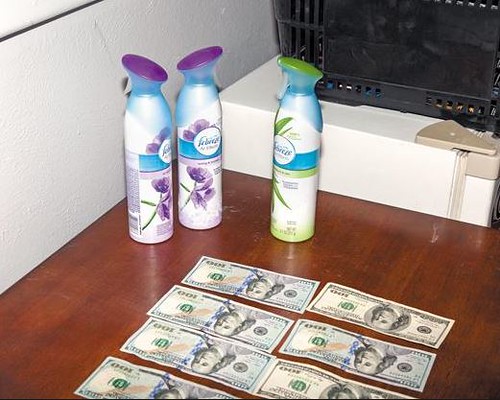
To read the complete article, see: Navigating Legal Pot's All-Cash Economy (www.businessweek.com/articles/2014-02-27/navigating-legal-pots-all-cash-economy)
A STUDENT OF TIPPING STRATEGY
"What's the usual tip?" a man growled when a University of South Carolina student delivered his pizza.
"Well," the student replied, "this is my first delivery, but the other guys said that if I got a quarter out of you, I'd be doing great."
"That so?" grunted the man. "In that case, here's five dollars."
"Thanks," the student said, "I'll put it in my college fund."
"By the way, what are you studying?"
"Applied psychology."
Teacher: Tommy, can you tell us where the Declaration of Independence was signed?
Tommy: Yes, ma'am. At the bottom.
To read the complete articles, see:
Pizza Delivery
(www.gcfl.net/archive.php?funny=7051)
Various American Independence Day Jokes
(www.gcfl.net/archive.php?funny=7053)
BOOKBENCHES INVADE LONDON
Books about Town launched to the public today with benches shaped like open books popping up all over the capital for Londoners, families and visitors to find and enjoy.
The BookBenches feature stories linked to London and are based on a range of iconic books from treasured children’s stories such as The Lion, the Witch and the Wardrobe and Peter Pan to classic adult titles including 1984 and The Day of the Triffids.
The new Books about Town website also launched today with a range of exciting features, including family events, activities and quizzes, downloadable trail maps, artist profiles and information on each BookBench.
Samuel Pepys Diary Book Bench
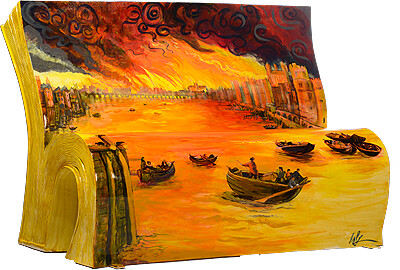
Samuel Pepys (1633-1703) was an English naval administrator and Member of Parliament who is now most famous for the diary he kept for a decade while still a relatively young man. The detailed private diary Pepys kept from 1660 until 1669 was first published in the 19th century, and is one of the most important primary sources for the English Restoration period. It provides a combination of personal revelation and eyewitness accounts of great events such as the Great Plague, the Second Anglo-Dutch War and the Great Fire of London.
Paddington Bear Book Bench
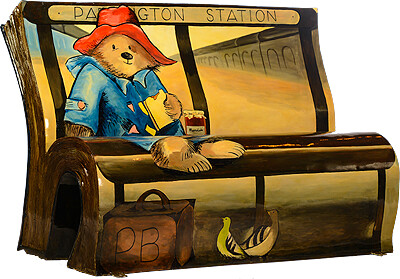
Do you know the story of London’s most iconic bear?
Although Paddington now lives in London, England, he originally came from Darkest Peru where he was brought up by his Aunt Lucy. When Aunt Lucy went to live in the Home for Retired Bears in Lima, she decided to send him to live in England. Eventually, Paddington arrived at Paddington Station in London where he was found by Mr and Mrs Brown. He was sitting on a small suitcase with a label round his neck with the words “Please Look After This Bear. Thank You.” Unable to resist such a simple request, Mr and Mrs Brown took Paddington home to live with them and their two children, Jonathan and Judy and their housekeeper, Mrs Bird. The stories that followed about Paddington Bear and his adventures have delighted children for decades.
Steven Hawking Hawking Book Bench
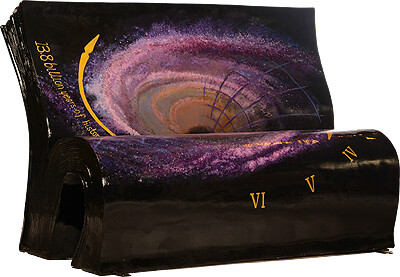
A Brief History of Time, published in 1988, was a landmark volume in science writing and received worldwide acclaim and popularity. The original edition was on the cutting edge of what was then known about the origins and nature of the universe. But the ensuing years have seen extraordinary advances in the technology of observing both the micro- and the macrocosmic world – observations that have confirmed many of Hawking's theoretical predictions.
For more information, see: www.booksabouttown.org.uk
To view the list of benches, see: http://www.booksabouttown.org.uk/?action=ListBenches
FEATURED WEB PAGE: COIN CABINET OF THE ROYAL LIBRARY OF BELGIUM
This week's Featured Web Page is a CoinsWeekly article about the digitization of the Coin Cabinet of the Royal Library of BelgiumThe Coin Cabinet of the Royal Library of Belgium digitized a large number of medals and coins the past few years. Although the work is still far from being finished, some collections are already available for researchers.
All objects are presented with an image of the obverse and reverse, a description in French or Dutch and the weight, diameter and material. In total, more than 22,400 descriptions are available online and work progresses on a daily base. The database covers mainly Belgian medals from 1794 and is up-to-date until 1911.
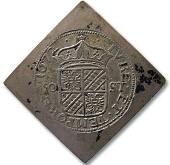
www.coinsweekly.com/en/News/4?&id=2864
